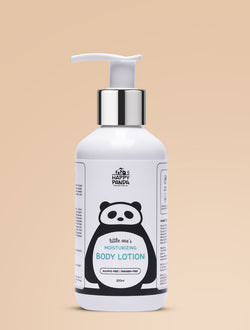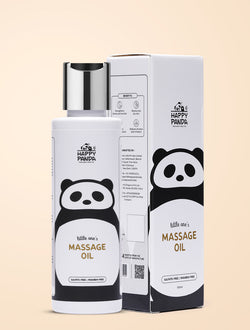Diaper rash is one of the most common skin conditions affecting infants, with studies showing nearly 50% of babies experience it at some point during their diaper-wearing years. This irritating condition occurs when the delicate skin in the diaper area becomes inflamed, often appearing as red, tender patches that can cause significant discomfort for your little one. As a parent, recognising, preventing, and properly treating diaper rash is essential for maintaining your baby's comfort and well-being.
Happy Panda, a leader in gentle baby care products, brings you this comprehensive guide to understanding diaper rash. We'll explore the science behind why diaper rash occurs, effective prevention strategies, evidence-based treatment approaches, and how choosing the right diaper products can make all the difference in keeping your baby's skin healthy and rash-free.
The Science Behind Diaper Rash: Why It Happens
To effectively prevent and treat diaper rash, it's important to understand what causes it. Several factors contribute to the development of diaper dermatitis:
1. Moisture and Friction
The diaper environment creates constant moisture from urine and stool. When combined with the friction of diaper movement, this breaks down the skin's natural protective barrier. Modern disposable diapers like Happy Panda Premium Absorbent Diapers help by wicking moisture away from the skin.
2. pH Changes
Urine raises the skin's pH level, activating enzymes in stool that further irritate the skin. This explains why diarrhoea often leads to severe diaper rash.
3. Microbial Factors
The warm, moist diaper area creates ideal conditions for yeast (Candida) and bacterial overgrowth, which can complicate simple diaper rash.
4. Chemical Irritants
Some babies react to fragrances, dyes, or chemicals in certain diaper brands or wipes. Happy Panda products are specifically formulated to minimise this risk.
Recognising Different Types of Diaper Rash
Not all diaper rashes are the same. Being able to identify the type helps guide proper treatment:
1. Irritant Dermatitis: The most common type, appearing as red, shiny patches on convex surfaces that touch the diaper.
2. Candida (Yeast) Infection: Bright red rash with satellite lesions, often lasting more than 3 days.
3. Bacterial Infection: May show pus-filled blisters or honey-coloured crusting.
4. Allergic Reaction: Typically appears suddenly after introducing new products.
Suggested Article - Newborn Bathing Guide: How to Choose the Safest Baby Shampoo & Body Wash
Evidence-Based Prevention Strategies
Preventing diaper rash is always preferable to treating it. Follow these research-backed strategies:
1. Frequent Diaper Changes
Change diapers every 2-3 hours, or immediately after bowel movements. Happy Panda diapers feature a wetness indicator to help parents know when changes are needed.
2. Gentle Cleansing Technique
Use alcohol-free, fragrance-free wipes (like Happy Panda Baby Wipes) and pat rather than rub the skin.
3. Barrier Protection
Apply a thin layer of zinc oxide or petroleum jelly with each change to protect the skin.
4. Optimal Diaper Fit
Choose diapers that fit snugly but aren't too tight. Happy Panda's flexible waistbands prevent chafing while containing messes.
5. Air Time
Allow 10-15 minutes of diaper-free time daily to let skin breathe.
Effective Treatment Approaches
When prevention falls short, these treatment methods are most effective:
1. Increased Diaper Changes: Change even more frequently during rash episodes.
2. Gentle Cleansing: Use warm water and soft cloths for severe rashes instead of wipes.
3. Thick Barrier Creams: Apply medicated zinc oxide creams with each change.
4. Anti-fungal Treatment: For suspected yeast infections, use an OTC anti-fungal cream.
5. Pain Management: Cool compresses can soothe discomfort between changes.
Why Happy Panda Diapers Help Prevent Rash
Happy Panda diapers incorporate several rash-preventing features:
- Breathable Outer Layer: Allows air circulation while containing moisture
- Super-Absorbent Core: Pulls wetness away from skin
- Wetness Indicator: Helps parents change diapers promptly
- Hypoallergenic Materials: Reduce chemical irritation risk
- Soft, Flexible Design: Minimises friction
When to Seek Medical Attention
Consult your paediatrician if:
- Rash doesn't improve in 3 days
- Blisters, pus, or bleeding develop
- Baby develops a fever
- Rash spreads beyond diaper area
- You suspect an allergic reaction
Common Myths About Diaper Rash
Myth: Only cloth diapers prevent rash.
Fact: Modern disposables like Happy Panda can be equally effective when changed frequently.
Myth: Powder is necessary to prevent rash.
Fact: Most paediatricians discourage powder use due to inhalation risks.
Myth: All babies get rash no matter what you do.
Fact: With proper care, many babies rarely experience significant rash.
Long-Term Skin Health Considerations
Chronic or severe diaper rash can lead to:
- Increased skin sensitivity
- Secondary infections
- Discomfort affecting sleep and mood
Investing in quality diaper products like Happy Panda from the beginning helps establish healthy skin that's more resistant to irritation.
Conclusion: A Rash-Free Future
By understanding the causes of diaper rash and implementing these prevention and treatment strategies, parents can significantly reduce their baby's discomfort. Choosing thoughtfully designed products like Happy Panda diapers and wipes creates the foundation for healthy skin that allows babies to stay happy, comfortable, and focused on the important business of growing and exploring their world. Remember that occasional mild redness is normal, but with proper care, severe diaper rash doesn't have to be an inevitable part of infancy.



